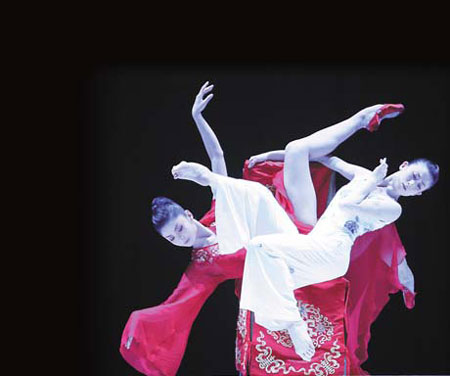Runner-up: Der Rosenkavalier by Deutsche Oper Berlin
This touring production as part of the Beijing International Music Festival opened up the eyes of opera aficionados to a masterpiece by Richard Strauss and an iconic treatment by the renowned Gotz Friedrich. It was a night to remember at Beijing's Poly Theater.
Splendid
Produced by China National Acrobatic Troupe
This is virtually a must-see for foreign visitors, but domestic audiences will love it too.
Billed as "the artistic conception acrobatics", it has come a long way since the old days when Chinese acrobatics was all stunts and no art. The current show is polished like a dance drama, with as much production values (sound, lighting, etc) as a lavish extravaganza, and still keeps it well paced.
The Chinese art of juxtaposing movements and quietude is accentuated. The yin of plate spinning, umbrella and diabolo juggling compliments nicely with the yang of pole and hoop jumping.
The stage setting is abstractly Chinese, with a few traditional objects in the foreground. The opening is very folksy, with lantern-like ornaments floating among the audience. The show had moments of spontaneity and dramatic tension. The best number in terms of audience reaction was tumbling through hoops.
"What is a human body capable of?" I asked myself after watching this stunt-filled artfully produced festivity. Call it the "Splendid human body".
Runner-up: Colorful Guizhou
The third edition of this perennial favorite with tourists had a touch of modern dance, which took on a special quality of singularity and haunting beauty. The show is based in Guiyang, capital of Guizhou province, but occasionally tours around the country.
The Riddle of Tibet
By Yang Liping and company
This revival of a variety show-cum-dance drama has so much to offer that anyone who loves Tibetan culture, Buddhism or the "Princess of Peacock" should not miss it. It was Yang Liping's follow-up to her wildly successfully Dynamic Yunnan show.
Yang is arguably China's most important dancer today, and she is not content with making quick money from appearing in television song-and-dance routines. She wants to showcase China's ethnic minorities in their authentic glory. She has done that for her own people from Yunnan, and this time she had done it again for Tibetan culture.
The show tells the story of an old Tibetan lady who takes her sheep on a pilgrimage to a sacred place. The audience follows her journey, which exposes her to the customs and practices of different tribes. The mostly Tibetan performers are full of energy and yet exude soulful and haunting qualities. Yang plays a Tibetan goddess in a solo number, and leads another dance dressed as a man.
"I have been fascinated by Tibetan dance for a long time. Every time I see Tibetans get down on their hands and knees to crawl slowly on a pilgrimage, I feel their every movement is a dance," Yang says.
Runner-up: The Nederlands Dans Theater
The Nederlands Dans Theater (NDT) made two trips to China this year, one in May by NDT II and one in October by NDT I. The program included Wings of Wax, a hymn to freedom inspired by the myth of Icarus, which is choreographed by Jiri Kylian.
Peony Pavilion the dance drama
Produced by the Nanjing Qianxian Song and Dance Company

It opened this year's Shanghai International Arts Festival and was a tribute to the Kunqu original, the 16th-century supernatural love story.
Choreographed by Ying Zhiqi, Lu Ling and Wu Ning, this four-act full-length dance drama revolves around the love between Du Liniang and Liu Mengmei, a love that extends over three lifetimes. Fang Ming composes the score, while award-winning dancer Hu Qinxin is Du and Xu Peng plays Liu.
Runner-up: Medea
Choreographed by Dimitris Papaioannou, the brain behind the much-acclaimed Opening Ceremony of the Athens Olympics, this revival, staged specially as part of Meet in Beijing Festival, had received plaudits from around the world. With its visual power and ingenious coupling of silent, stylized movement, the tale of a woman wronged from Greek mythology has not lost an iota of power and majesty. The music is a collage of Vincenzo Bellini's operas.
Ming
Directed by Tian Qinxin
Shakespeare's King Lear was given a makeover a la Akira Kurosawa: It was relocated to China's Ming Dynasty.
The old Emperor of the Ming Dynasty thinks of abdicating the throne, but cannot decide which of his three sons should get it, the effete eldest son, the cruel second son or the honest youngest one. In the race for power, people go crazy, are used, find themselves in key positions, lose out and even die.
Playwright Shi Yue is known for his series of historical novels about the Ming Dynasty (1368-1644), which helped set off a craze for anything Ming. He found parallels between the two worlds. The costumes change, but human nature remains the same. Power corrupts. The Shakespearian theme can be found anywhere, any time.
Runner-up: Hamlet
The prince of Denmark is a constant feature on Chinese stages, but director Lin Zhaohua has given it a slight new twist in his revival: He had his star-studded cast wear their daily clothes.
Lin first staged Hamlet in Beijing in 1990, drawing long queues in front of the box office. The drama that boldly strayed away from conventional productions made a big splash.
This year's production was designed with astonishing simplicity. Pu Cunxi reprised the title role, but the theme is "Everyone could be Hamlet" as role changes occurred periodically among actors.
(China Daily December 31, 2008)